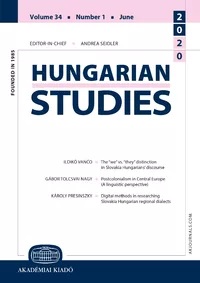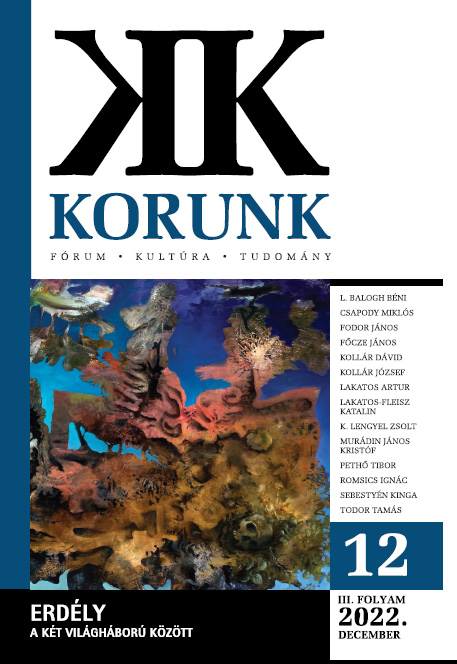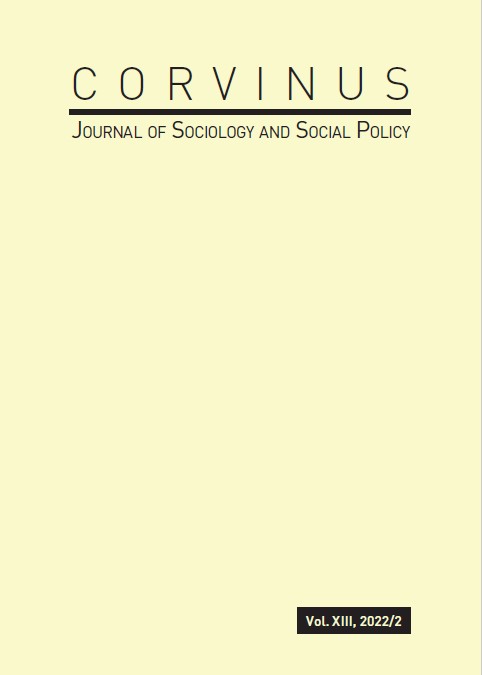
Wolfgang Benz: Sinti und Roma: Die unerwünschte Minderheit. Über das Vorurteil Antiziganismus
review of: Wolfgang Benz: Sinti und Roma: Die unerwünschte Minderheit. Über das Vorurteil Antiziganismus, Berlin, Metropol-Verlag 2014, 316 pp.
More...We kindly inform you that, as long as the subject affiliation of our 300.000+ articles is in progress, you might get unsufficient or no results on your third level or second level search. In this case, please broaden your search criteria.

review of: Wolfgang Benz: Sinti und Roma: Die unerwünschte Minderheit. Über das Vorurteil Antiziganismus, Berlin, Metropol-Verlag 2014, 316 pp.
More...
This study deals with a still not sufficiently studied phenomenon of social exclusion in the Czech rural regions. On the case of Osoblaha, we point out the influence of regional characteristics of social inclusion on the transformation of the region’s social structure. The disadvantage of a region in the spheres of employment, education, community facilities and transport services contributes to emigration of relatively educated population able to work; such population is, to certain degree, substituted by socially excluded persons seeking relatively cheaper housing; and that contributes to increasing local social tension. Together with the analysis of the current status of social exclusion in the Osoblaha Region, based on quantitative and qualitative data, we present, as the main finding, the need of further dealing with the impact of public policies on shaping of social exclusion in excluded rural regions.
More...
For a long time, university education for national minorities has been a blind spot in minority research. The situation of university education in South Tyrol seems to be an exception, because in South Tyrol the question of higher education, for many years, has been the subject of intensive political and academic discussion. This discussion may be seen as paradigmatic since it includes both the concept of ethnic segregation and the concept of universality. In this paper, we focus on the legal basis and the praxis of university education in South Tyrol which is a compromise between ethnic segregation and multicultural universality. In recent years, the Free University of Bozen has become a symbol for overcoming segregation and it opened a new perspective to the members of the two major language groups in South Tyrol.
More...
The author addresses on a multidisciplinary platform and from the theoretical legal and philosophical legal perspective the issue of minorities and multicultural education at universities. Through its criticism she reveals the emptiness and confusion of the concepts of social sciences and humanitarian disciplines and brings to light the ‘asset stripping’ of the normative systems. Multiculturalism in the context of a value-based university education is presented as relativism applied in the field of the social sciences with repercussions on social engineering and complete transformation of cultural and social values. Her conclusions about value perception and interpretation of multidisciplinary concepts of multiculturalism unearth in the final analysis concurrent processes leading to ideologization of scholarly disciplines and in particular law, which ceases to be a value and becomes a means used by the power structures of the globalized world.
More...
The purpose of the article is to give an overall description of the situation of Hungarian minority households with children in Ukrainian villages. The region is a marginal area both economically and geographically, being in a peripheral position with little attention falling upon it and even less of the development sources. Furthermore, there is a lack of information on welfare benefits, and no direct statistical data are available on the characteristics of the social policy system. As for the total lack of prior statistics on poverty, this essay is meant to be exploratory to show the area’s poverty features, focusing on the children. By the use of combined data collection, including quantitative and qualitative techniques, we gained information by questionnaire surveys of about 253 children in 139 households. There were carried out 23 exploratory interviews as well. The core of our analysis is the specific labour market situation, the earning opportunities, and forms of employment that provide for livelihoods for the households with children. Besides the backwardness of the area studied in the research, the strategies and life situations that characterize the Transcarpathian Hungarians are also presented, which are beyond the known European forms of poverty.
More...
The present paper provides an overview of the ways in which Hungarian language issues in Slovakia have been handled from the 1990s to the present, discussing language cultivation, language planning and language management, and summarizing, on the basis of contemporary articles and studies, how the theoretical principles of these directions of research are implemented in the Slovakia Hungarian practices of handling language issues, and, on the other hand, how practical actions of problem handling contribute to theoretical frameworks of shaping language. These results are viewed in their historical contexts throughout the paper, and, at the end, the continuation of earlier processes is also traced in today’s linguistic research.
More...
The aim of the present research is to analyse how some Roma in Romania become educationally mobile. Based on the cultural wealth model and the constructivist approaches to ethnicity and scholarship in relation to cultural racism, I intended to take stock of the forms of capital Roma persons make use of when ascending. I considered that the narrative type of interviews could be a successful means of generating a better understanding of the meaning and functioning of capitals. Narratives inform us that the same type of capital may appear in different forms: family capital may denote not ‘just’ the transmission of the importance of education to children but protection from racial insults, too. Institutional agents (as sources of social capital acquisition) – despite their good will – may equally facilitate the inclusion of and reproduce unequal racial categorization. Behaving differently, in opposition to the stereotypes associated with the Roma (low educational attainment, early marriage, poverty), is a conscious choice that may help many of the Roma to resist racial attacks.
More...
The article concerns relations between Slovaks and the Hungarian minority in Slovakia. The aim of this study is to determine current Slovak attitudes towards the Slovak Hungarians and to analyse differences in attitudes held by Slovaks in regular direct contact with the Hungarian minority and those with almost no contact. Another aim is to map current attitudes among the Hungarian minority towards the Slovak majority, and to find out how Slovak attitudes are perceived by the minority. The data collection methods were a survey (N = 107) and focus group interviews (N = 36). The results show that Slovaks in regular contact with Slovak Hungarians have significantly more positive general feelings, are less socially distant, and feel less anxious about the Hungarian minority than Slovaks with almost no contact. There were no statistically significant differences between the two groups in terms of trust and behavioural intention. Group interviews with Slovaks and Slovak Hungarians showed that the biggest obstacle in relations between Slovaks and the Hungarian minority is first language use and the language barrier.
More...
In his article, the author offers an overview of the presentations given at the international conference entitled 100 Years of Hungarian Minorities, organised by the Hungarian Academy of Sciences.
More...
This paper shows how history is rewritten in China by shaping the memories of its youth, who create new communities by sharing and renarrating new memories. They can become a powerful channel to convey an official interpretation of local histories to a larger public, by marginalizing and appropriating local narratives. The idea behind the program for voluntary narrators under analysis1 is to shape memories of China’s young and wealthy students about a place, by transforming its rich cross-cultural fundamentals, symbolic and inner meanings, into a representation of the Nation, able to convey powerful declinations of official narratives on the history of China. The analysis is conducted in consideration of the larger context of the construction and transmission of the official discourse on national identity in contemporary PRC. Specifically, the author provides evidence of how young Chinese internalize and disseminate the party line on Chineseness, and the subordinate role assigned within this process to “minorities.” Minorities are seen both as a threat and an opportunity: a threat to the Party and social cohesion as carriers of diverse identities, an opportunity for contrasting Chineseness with the Other, a backward entity, inadequate and unable to embrace—if not help— the path to modernity.
More...
This paper will discuss the Wiindigo, a cannibalistic character among some Indigenous peoples of North America. Illustrated through the Anishinaabeg and Oji-Cree, two Algonquin-speaking Indigenous groups, the Wiindigo serves as a personification of fear and hunger, and alludes to the cultural heritage elements of the boreal forest food system as well as the differing legal systems in Canada. In examining the Wiindigo from the Indigenous cultural and historical perspec- tives related to the author by several knowledge-holders, as well as from Euro- Canadian popular culture representations, the paper illustrates the importance of the Wiindigo to Anishinaabe and Oji-Cree world views, customary governance, and contemporary lived experience.
More...
The article deals with the position of national minorities in the former federal states of the Soviet Union. It deals specifically with the position of the Russian minority in the Baltic countries and in Ukraine. Based on the analysis and comparison, it examines and describes the position of this minority in society and examines and evaluates the observance of its civil and minority rights. The Baltic States are all currently members of the EU and NATO. In this context, the article notes how the standards of human and minority rights protection typical of democratic states in Europe are respected in these countries, as well as the criteria and requirements for the protection of human (civic) and minority rights by the European Union. The article is based on the premise that the standards and criteria that both the European Union and the Council of Europe place for the protection of minorities in these countries in relation to the Russian minority are not met. These countries deliberately do not meet these standards, and there is no response from the EU to such a situation.
More...
The main aim of this report is to prove that the war migrants in the low-industrialised areas are deepening structural problems on local job market. The Sepolno Krajenskie region was selected for evaluation as this region (compared to the entire voivodeship and country) is struggling with the problem of relatively high unemployment. In June 2022, the unemployment rate was almost double the average for Poland and over 40% higher than the average for the voivodeship. The target of the research was proven through the analysis-based deduction method of secondary and primary data obtained through a questionnaire survey in a group of war migrants living in the Sepolno Krajenskie region, a library query, and statistical data and information available through the Poviat Labour Office in Sepolno Krajenskie. Based on the data analysis, it was confirmed that the arrival of young Ukrainian women extended the already existing problem of the excess of women in the local population, which impacts the growing number of unemployed women (by 8.62% in July 2022 compared to December 2021 in Sepolno Krajenskie). Another challenge for the local job market is the fact that the female migrants are not able to take all available jobs as they are limited by the language barrier and the insufficient childcare offered to them. Moreover, about 13% of the children are in school age, so in the near future, they will become job-seekers as well.Assuming that some of the incoming migrants stay in Poland permanently (only every 4th woman has declared the will to do so), we can expect the average age of the inhabitants of the region to decrease in the long-term, the birth rate to increase and the predicted deficit of reproductive-age people to decrease, which may affect the economic development in the future.
More...
Tearing down borders or the historical decline of categorial exclusion has not brought about the disappearance of exclusion. The principle of equality between people does not easily “translate” into real world facts, therefore socio-economic inequality between people or groups remains stubbornly persistent. The source of the tension is, on the one hand, the declarative recognition of equality in principle, morality, and law, and, on the other hand, the practical persistence of social inequalities: the social exclusion. The paper discusses the mechanisms and factors related to the subject, using the example of the ethnic exclusion of the Roma in Romania. The easy answers to uncomfortable questions more often slip into the field of scapegoating, victim-blaming, or even xenophobia. Real answers require confrontation: there is an inevitable problem of the continuous management of inequalities that persist despite of dismantled borders and equality in principle. I am convinced that we cannot remain indifferent and ignorant on these issues, since in many cases suffering is caused by one form of exclusion or another. Until we are made aware of how these operate, there is little chance of doing anything about them.
More...
Romani Communities and Transformative Change: A New Social Europe. (eds. Andrew Ryder, Marius Taba and Nidhi Trehan, Policy Press, 2021)
More...
The article in the theoretical part deals with minority identity, its revitalization and understanding what identity needs are. Attention was paid to the borderland as a special place for forming identity, especially ethnic and national identity. The second part of the article presents the transformation of identity needs of “Ukrainians from Podlasie”. This is an interesting and unique group, which has made an effort to revitalize its identity and in recent years has undergone a specific evolution of its identity needs: from a complete lack of the need for national identification and the emergence of strong needs for assimilation to Polish and Belarusian identity, through the needs related to revitalization, institutionalization and autonomy to the visible needs for equal, subjective treatment, education and integration. Although the article deals with the Ukrainian minority in the Podlaskie Voivodship in Poland, its findings apply universally to the transformation of ethnic and national minority identities in contemporary societies. The path of transformation of identity needs described in the article refers to many minorities and ethnic groups functioning in modern democracies in Europe and in the world.
More...
This journal review presents Slovak and Hungarian print and online periodicals dealing with ethnic studies, looking at some of their prominent authors and most recent issues.
More...
Discussion paper for a previously published article on the problems of the Hungarian Roma.
More...
During a research in 2015 on the representation of Roma culture among content regulators and content carriers, as well as their development opportunities, we investigated whether the optional textbooks for teaching in public education contain relevant information about the domestic nationalities, with a focus on the Roma population, which could be mandatory elements of the basic knowledge material according to the requirements of the Hungarian National core curriculum, the Framework Curricula, and the local curricula based on them. (see Orsós 2015, 2016; Csapó Cserti 2016; Andl– Cserti 2017) In the research we reviewed the results of previous studies on this topic (Terestyéni 2004; Balázs et al. 2014; Binder–Pálos 2016). The first examination of the textbooks ended with very negative experiences. The optional textbooks rarely contained information about nationalities in Hungary, and among them, this neglect was even more noticeable in relation to Roma. Despite the fact that each subject is suitable for meeting the content and sensitization expectations for national minorities set out in the curricula, it conveys social acceptance and a multicultural approach. Contents were published just in some of the examined textbooks, but these were without exception either inaccurate or rather hid the danger of deepening stereotypical thinking. It also became clear how difficult task it is for the textbook author to simultaneously meet the curriculum requirements of the education policy, the age characteristics and previous professional knowledge of the students, the professional expectations of the teachers society, and the content, visual and didactic expectations of textbooks (see Dárdai 2002; Balázs et al. 2017), together with social and parental needs, the actual school frameworks and possibilities of teaching geography should also be taken into account (e.g. number of lectures, professional knowledge of practicing teachers, their social sensitivity, etc.). From this latter point of view, the study reflects on what and how can be taught from the “customer’s package” required by the domestic education policy in relation to the socio-economic-territorial approach of the nationalities, including the Roma population.
More...